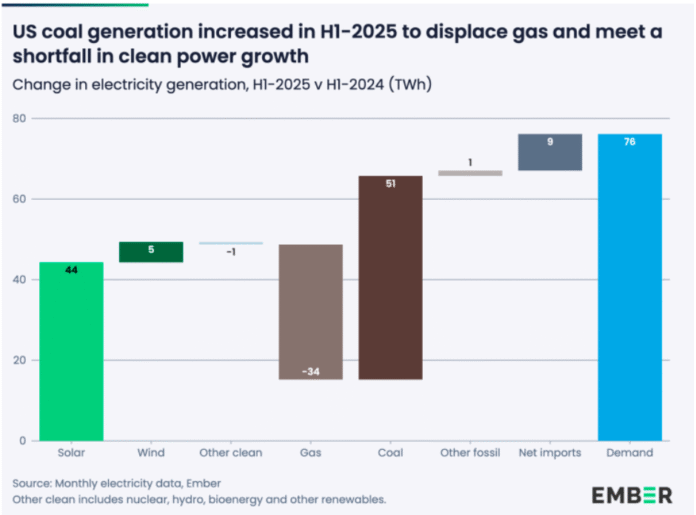The United States — the world’s largest economy — accounted for 15 percent (2,190 TWh) of global electricity demand and 12 percent of global power sector CO₂ emissions during the first half of 2025. Unlike China, where renewables grew faster than electricity demand, the U.S. saw solar and wind expand at a slower pace, meeting only 65 percent of the increase. This shortfall allowed coal generation to rise, partly replacing natural gas and driving a notable uptick in emissions.
Renewables Struggle to Keep Up with Strong Electricity Demand Growth
In the first half of 2025, U.S. electricity demand grew by 76 TWh (3.6 percent), compared with 93 TWh (4.6 percent) in the same period last year, when severe heatwaves boosted consumption. The 2025 increase marks a significant change from the relatively flat electricity demand seen between the mid-2000s and early 2020s, according to new analysis from Ember.
According to the U.S. Energy Information Administration (EIA), electricity use is expected to continue climbing due to rising consumption in the commercial sector—particularly from data centers—and in the industrial sector, driven by expanded manufacturing activity.
Solar energy generation rose by 44 TWh (30 percent), meeting 58 percent of total demand growth and increasing its share in the power mix to 8.7 percent, up from 6.9 percent a year earlier. Wind generation, however, increased only by 5 TWh (2 percent), well below the 19 TWh (8.1 percent) growth recorded in the first half of 2024. As a result, wind’s share of the electricity mix fell slightly from 11.7 percent to 11.5 percent, largely due to unfavorable wind conditions across several months, including February, April, May, and June.
Hydropower showed modest improvement, adding 5 TWh (4.1 percent), compared to just 1 TWh (0.8 percent) growth last year. In contrast, nuclear generation declined by 5.2 TWh (1.4 percent).
Overall, the strong rise in electricity demand pushed fossil fuel generation up by 18 TWh (1.6 percent), leading to a 33 MtCO₂ (4.3 percent) increase in emissions during the first half of 2025.
Coal Makes a Comeback as Gas Declines
A notable shift in the U.S. power mix during 2025 was the reversal of the long-term gas-dominant trend. Natural gas generation declined by 34 TWh (3.9 percent), after having increased by 44 TWh (5.4 percent) in the first half of 2024. This reduction lowered gas’s share in the electricity mix from 40.6 percent to 37.9 percent.
Coal generation, on the other hand, rose sharply by 51 TWh (17 percent), compared with just 3.5 TWh (1.2 percent) growth in H1 2024, raising its share from 14.4 percent to 16.2 percent. This gas-to-coal switch was largely driven by higher natural gas prices, making coal a more attractive option for power producers despite its higher emissions.
Outlook
The U.S. energy landscape in 2025 highlights a growing challenge: renewable generation is not expanding fast enough to keep up with strong demand growth. While solar power continues its impressive upward trajectory, wind output stagnated, and fossil fuels — particularly coal — regained ground.
Unless renewable energy capacity additions accelerate significantly, the U.S. risks undermining its decarbonization goals and seeing further increases in power sector CO₂ emissions in the coming years.
Baburajan Kizhakedath

